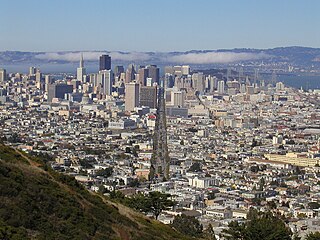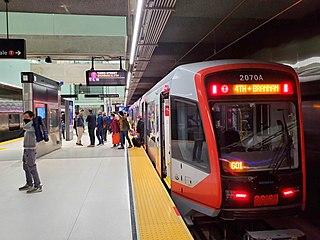
San Francisco, officially the City and County of San Francisco, is a city in the U.S. state of California. It is the commercial, financial, and cultural center of Northern California. With a population of 808,437 residents in 2020, it is the fourth most populous city in California and the 17th most populous city in the United States. The city covers a land area of 46.9 square miles at the end of the San Francisco Peninsula, making it the second-most densely populated large U.S. city after New York City and the fifth-most densely populated U.S. county, behind only four of the five New York City boroughs. Among the 92 U.S. cities proper with over 250,000 residents, San Francisco was ranked first by per capita income and sixth by aggregate income as of 2022. Colloquial nicknames for San Francisco include Frisco, San Fran, The City, and SF.

Treasure Island is an artificial island in the San Francisco Bay, and a neighborhood in the City and County of San Francisco. Built in 1936–37 for the 1939 Golden Gate International Exposition, the island was named by Clyde Milner Vandeburg, part of the Fair's public relation team. Its World's Fair site is a California Historical Landmark. Buildings there have been listed on the National Register of Historic Places, and the historical Naval Station Treasure Island, an auxiliary air facility, are designated in the Geographic Names Information System. Treasure Island is connected to Yerba Buena Island, another auxiliary island of San Francisco, by a causeway, creating access to Interstate 80.

South of Market (SoMa) is a neighborhood in San Francisco, California, situated just south of Market Street. It contains several sub-neighborhoods including South Beach, Yerba Buena, and Rincon Hill.

Arthur Christ Agnos is an American politician. He served as the 39th mayor of San Francisco, California from 1988 to 1992 and as the Regional Head of the United States Department of Housing and Urban Development from 1993 to 2001.

Yerba Buena Gardens is the name for two blocks of public parks located between Third and Fourth, Mission and Folsom Streets in the South of Market (SoMA) neighbourhood of San Francisco, California. The first block bordered by Mission and Howard Streets was opened on October 11, 1993. The second block, between Howard and Folsom Streets, was opened in 1998, with a dedication to Martin Luther King Jr. by Mayor Willie Brown. A pedestrian bridge over Howard Street connects the two blocks, sitting on top of part of the Moscone Center convention center. The Yerba Buena Gardens were planned and built as the final centerpiece of the Yerba Buena Redevelopment Area which includes the Yerba Buena Center for the Arts. Yerba Buena Gardens Conservancy operates the property on behalf of the City and County of San Francisco.

The Embarcadero is the eastern waterfront of Port of San Francisco and a major roadway in San Francisco, California. It was constructed on reclaimed land along a three mile long engineered seawall, from which piers extend into the bay. It derives its name from the Spanish verb embarcar, meaning "to embark"; embarcadero itself means "the place to embark." The Central Embarcadero Piers Historic District was added to the National Register of Historic Places on November 20, 2002.

The Central Subway is a Muni Metro light rail tunnel in San Francisco, California, United States. It runs between Chinatown station in Chinatown and a portal in South of Market (SoMa), with intermediate stops at Union Square/Market Street station in Union Square and Yerba Buena/Moscone station in SoMa. A surface portion runs through SoMa to connect to the previously existing T Third Street line at 4th and King station.

The Fillmore District is a historical neighborhood in San Francisco located to the southwest of Nob Hill, west of Market Street and north of the Mission District. It has been given various nicknames such as "the Moe" or "the Fill". The Fillmore District began to rise to prominence after the 1906 San Francisco earthquake. As a result of not being affected by the earthquake itself nor the large fires that ensued, it quickly became one of the major commercial and cultural centers of the city.

The Children's Creativity Museum is an interactive museum for children aged 2–12 years, located in Yerba Buena Gardens, in San Francisco, California. It offers workshops and exhibits that allow children to produce their own media through various interactive, creative processes: stop motion animation, programming robots, music video production, design challenges, art projects, and more. It has around 100,000 museum visitors annually. The Children's Creativity Museum is a nonprofit 501(c)(3) organization, with annual revenues of around $2.1 million, including $600,000 of funding from the city of San Francisco.

Visitacion Valley, colloquially referred to as Viz Valley, is a neighborhood located in the southeastern quadrant of San Francisco, California.

Market Street is a major thoroughfare in San Francisco, California. It begins at The Embarcadero in front of the Ferry Building at the northeastern edge of the city and runs southwest through downtown, passing the Civic Center and the Castro District, to the intersection with Portola Drive in the Twin Peaks neighborhood. Beyond this point, the roadway continues into the southwestern quadrant of San Francisco. Portola Drive extends south to the intersection of St. Francis Boulevard and Sloat Boulevard, where it continues as Junipero Serra Boulevard.

The Treasure Island Development is a 405-acre (164 ha) major redevelopment project under construction on Treasure Island and parts of Yerba Buena Island in San Francisco Bay between San Francisco and Oakland, within San Francisco city limits. The Treasure Island Development Authority (TIDA) is a nonprofit organization formed to oversee the economic development of the former naval station. Treasure Island's development was set to break ground during mid-2012. However, on April 12, 2013, The San Francisco Chronicle reported that the deal has collapsed, with the Chinese investors from China Development Bank and China Railway Construction Corporation withdrawing from the project. The Treasure Island Project is being developed by a joint venture between Lennar and Kenwood Investments. The development is expected to cost US$1.5 billion.

San Francisco Bay Area Planning and Urban Research Association, commonly abbreviated as SPUR, is a think tank focused on urban policy in San Francisco Bay Area.

Jane Jungyon Kim is an American attorney and politician, and the first Korean American elected official in San Francisco. She represented San Francisco's District 6 on the Board of Supervisors between 2011 and 2019. She is a member of the San Francisco's Democratic County Central Committee. She is executive director of the California Working Families Party.
M. Justin Herman (1909–1971) was an American public administrator. From 1951 to 1959 he was head of the regional office of the Housing and Home Finance Agency in San Francisco, California. From 1959 until his death in 1971, he was the Executive Director of the San Francisco Redevelopment Agency. Under his administration, large areas of the city were redeveloped; thousands of residents, many of them poor and non-white, were forced to leave their homes and businesses.

Robert Pitts (1909-1982) was the first African-American to serve as a Regional Administrator of the US Department of Housing and Urban Development (HUD).

Yerba Buena/Moscone station is an underground Muni Metro light rail station located at 4th Street and Folsom Street in the South of Market (SoMa) district of San Francisco, California. It is named for the adjacent Yerba Buena Gardens and Moscone Convention Center. It opened on November 19, 2022, as part of the Central Subway project. The station is served by the T Third Street line which runs between Chinatown and Sunnydale.

Four Seasons Private Residences at 706 Mission Street, San Francisco is a 43-story, 510 ft (160 m) residential skyscraper under construction in the South of Market district of San Francisco, California. Located across the street from Yerba Buena Gardens and Moscone Center, the tower site is bounded by Mission Street on the south and 3rd Street on the east, and will incorporate the historic Aronson Building in its design. The tower will contain up to 190 condominiums on the upper floors and a permanent home for the Mexican Museum on the bottom four floors.

Yerba Buena Gardens Festival is an admission-free performing arts festival held in San Francisco, California. During the summer months, May to October, Yerba Buena Gardens Festival produces concerts and performances including music, dance, theater, circus and children's programs. All programs take place in the outdoor spaces of Yerba Buena Gardens in the South of Market, San Francisco district.
Tenants and Owners Development Corporation, also known as TODCO, is a nonprofit organization that owns eight low-income apartment buildings in the South of Market neighborhood of San Francisco, California. Founded to oppose the redevelopment of the Yerba Buena corridor, the organization is a prominent and influential opponent of housing construction in San Francisco.




















